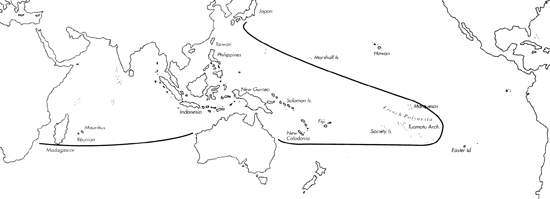
Skip Navigation Links
View access keys for this site.

Range: E. Africa to French Polynesia; absent from Marshall Is. and Hawaii.
Description: Medium-sized to moderately large, moderately solid to solid. Last whorl conoid-cylindrical, sometimes ventricosely conical, conical, or cylindrical; outline convex at adapical fourth, slightly convex to straight and parallel-sided below, with straightly tapering sides at basal third; left side constricted above base. Shoulder angulate to rounded. Spire of low to moderate height, outline straight to slightly concave or slightly sigmoid. Larval shell of about 2.75 whorls, maximum diameter 0.8-0.9 mm. First 4-5.5 postnuclear whorls tuberculate. Teleoconch sutural ramps slightly convex to slightly concave, with 0-1 increasing to 9-10 weak spiral grooves or more spiral striae. Last whorl with weak spiral ribs basally, sometimes extending beyond centre.
| Shell Morphometry | ||
|---|---|---|
| L | 35-70 mm | |
| RW | 0.17-0.44 g/mm | |
| (L 35-60 mm) | ||
| RD | 0.53-0.64 | |
| PMD | 0.74-0.86 | |
| RSH | 0.06-0.22 | |
Ground colour white, often suffused with pink or blue. Last whorl with yellowish brown spots and flecks and with a network of fine brown lines edging tiny to moderately large, round to tentlike ground colour markings. Similarly sized tents may be arranged in groups. Yellowish brown spots and flecks interspersed with broad dark brown axial lines, sometimes also with spiral lines, usually forming 2 interrupted spiral bands, within basal third and just above centre. Larval whorls pale pink. Early postnuclear sutural ramps pale pink. First 2-4 ramps immaculate, following ramps matching last whorl in colour pattern. Aperture pink, sometimes suffused with orange or violet.
Periostracum yellowish grey, thin, translucent, smooth.
Dorsum of foot buff, radially streaked and mottled with brown, with a black spot beneath the operculum and with a dotted black pre-marginal band ending in a blotch anteriorly; anterior side bright red, adjacent zone paler red and with a central black blotch. Sole of foot cream to pinkish buff. Rostrum mottled white and buff. Tentacles white, tipped with red. Siphon white, grading to red distally, mottled with brown proximally, and with a rather broad black ring centrally (Chaberman, pers. comm., 1981; Kohn, unpubl. observ.) (Pl. 76, Fig. 67).
Radular teeth with 2 opposed barbs adapically; long serration ending in a cusp about 1/6 of the length from the base; basal spur absent (Troschel, 1868; Endean & Rudkin, 1965, referred to as "C. tigrinus").
Habitat and Habits: Intertidal and uppermost subtidal; on subtidal coral reef flats, in sand under coral rocks, in coral rubble with or without sand and on limestone pavement, often close to living corals (Kohn & Nybakken, 1975; Chaberman, pers. comm., 1981; Richards, pers. comm., 1989; Lorenz, pers. comm., 1993). C. canonicus feeds on gastropods; venom toxic to molluscs but not to small mammals, fishes and polychaete worms (Endean & Rudkin, 1965; Kohn & Nybakken, 1975). Spawn of about 50 egg capsules deposited on the underside of rocks in about 1 m or near the reef crest. Capsules of 11-20 x 8.5-15 mm affixed to the substratum as well as to previously laid capsules; each containing 500-1,500 eggs. Egg diameter of 230-260 ┬Ąm predicting a minimum pelagic period of 21-18 days (Kohn, 1961b, listed there as "C. textile"; Perron & Kohn, 1985; Loch, pers. comm., 1987; Kohn & Perron, 1994).
Discussion: C. canonicus is similar to C. abbas, C. textile, C. legatus and C. aureus; for comparison, see the Discussions of those species. C. canonicus has often been referred to as "C. tigrinus", a synonym of C. textile. C. rubescens is based on a convex-sided specimen, C. condensus, on an elongate specimen of C. canonicus.

C. canonicus range map
This section contains verbatim reproductions of the accounts of 316 species of Conus from the Indo-Pacific region, from Manual of the Living Conidae, by R÷ckel, Korn and Kohn (1995). They are reproduced with the kind permission of the present publisher, Conchbooks.
All plates and figures referred to in the text are also in R÷ckel, Korn & Kohn, 1995. Manual of the Living Conidae Vol. 1: Indo-Pacific Region.
The range maps have been modified so that each species account has it own map, rather than one map that showed the ranges of several species in the original work. This was necessary because each species account is on a separate page on the website and not confined to the order of accounts in the book.
Return to framed version (returns to search page)